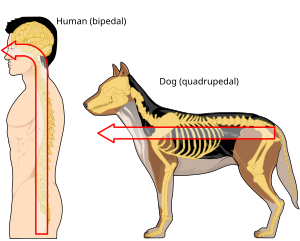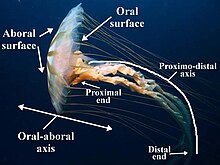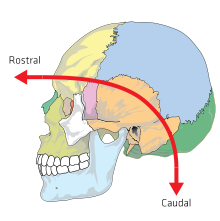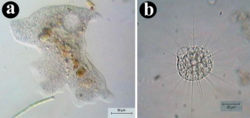Anatomical terms of location
Standard anatomical terms of location are used to describe unambiguously the anatomy of animals, including humans.The terms, typically derived from Latin or Greek roots, describe something in its standard anatomical position.Standard anatomical and zoological terms of location have been developed, usually based on Latin and Greek words, to enable all biological and medical scientists, veterinarians, doctors and anatomists to precisely delineate and communicate information about animal bodies and their organs, even though the meaning of some of the terms often is context-sensitive.[1] The reasoning is that the neuraxis is different between the two groups, and so is what is considered the standard anatomical position, such as how humans tend to be standing upright and with their arms reaching forward.Unique terms are also used to describe invertebrates as well, because of their wider variety of shapes and symmetry.For example, "anterolateral" indicates a position that is both anterior and lateral to the body axis (such as the bulk of the pectoralis major muscle).The same logic is applied to all planes of the body and, thus top-to-bottom or bottom-to-top X-ray projections are known as "superoinferior" and "inferosuperior," respectively.[21] For example, in the anatomical position, the most superior part of the human body is the head and the most inferior is the feet."Proximal and distal" are frequently used when describing appendages, such as fins, tentacles, and limbs.[31] This terminology is also employed in molecular biology and therefore by extension is also used in chemistry, specifically referring to the atomic loci of molecules from the overall moiety of a given compound.These two terms, used in anatomy and embryology, describe something at the back (dorsal) or front/belly (ventral) of an organism.The terms are used in other contexts; for example dorsal and ventral gun turrets on a bomber aircraft.The term "rostral" is rarely used in human anatomy, apart from embryology, and refers more to the front of the face than the superior aspect of the organism.References may also take origin from superficial anatomy, made to landmarks that are on the skin or visible underneath.For example, the mid-clavicular line is used as part of the cardiac exam in medicine to feel the apex beat of the heart.[2] Fields such as osteology, palaeontology and dentistry apply special terms of location to describe the mouth and teeth.For example, as humans are approximately bilaterally symmetrical organisms, anatomical descriptions usually use the same terms as those for other vertebrates.[62] In invertebrates, the large variety of body shapes presents a difficult problem when attempting to apply standard directional terms.Some such borrowed terms are widely applicable in most invertebrates; for example proximal, meaning "near" refers to the part of an appendage nearest to where it joins the body, and distal, meaning "standing away from" is used for the part furthest from the point of attachment.In organisms that maintain a constant shape and have one dimension longer than the other, at least two directional terms can be used.Usually such organisms are planktonic (free-swimming) protists, and are nearly always viewed on microscope slides, where they appear essentially two-dimensional.Radially symmetrical organisms include those in the group Radiata – primarily jellyfish, sea anemones and corals and the comb jellies."Lateral", "dorsal", and "ventral" have no meaning in such organisms, and all can be replaced by the generic term peripheral (from Ancient Greek περιφέρεια 'circumference').All the eyes are on the carapace of the prosoma, and their sizes, shapes and locations are characteristic of various spider families and other taxa.











Anatomical terminologyMicroanatomyMotionMuscleNeuroanatomyanatomyanimalshumansstandard anatomical positionanatomical planesanatomical axesbipedalquadrupedalinvertebratesTerminologia AnatomicaNomina Anatomica Veterinariaanatomistsveterinariansmedical doctorsneuraxisvertebrateinvertebrateanatomicalzoologicaldoctorsbipedsquadrupedsflounderappendagestentaclesMantophryne insignispectoralis majorradiologyanteriorposteriorAnatomical planemedian planespinal cordsagittal planescoronal planetransverse planeStentor roeseliiright anglesorthograde bipedalSpheroidtestesjellyfishChrysaoraprefixessubcutaneousAncient Greekhypoglossal nerveinfraorbital nerveintercostal musclessupraorbital ridgessuffixesanatomical positionAnterior (disambiguation)genitalscontralateral, side of the brainorchiectomystrokeweaknessvalgusGlossary of dentistryreproductive tract of snailsmoietycentral nervous systemperipheral nervous systemsgreat vesselsOld Englishexternal oblique muscleepidermissubcutisembryologypectoral finsanal findorsal finHominidaehorsesanatomical landmarksspinal vertebravertebral columncervical vertebrathoracic vertebralumbar vertebrasacrumsuperficial anatomyanterior superior iliac spinemedial malleolusmedial epicondyleAnatomical linescardiac examapex beatDental terminologyosteologypalaeontologydental archhard palateList of Amphibia characterspronatesupinatepalmar fasciatendonsdorsal venous archradiusfibulauterusbladderbimanual examinationrectumpelvisretroverted uterusadventitiaserosaperitoneumparietal bonevisceral painbody plansbilaterally symmetricalbody plankangaroobody shapesheliozoanamoeboidspherically symmetrical